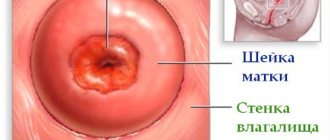The attitude of doctors towards cauterization of cervical erosion with electric current changes every year. A few decades ago, this procedure was actively practiced among gynecologists. Now she is preferred to more modern and improved methods of treating cervical erosion. It cannot be said that current treatment (also called electrocoagulation) has lost its effectiveness. This treatment method most often helps the first time and does not require additional procedures. However, a number of characteristics force specialists to refuse to use current.
The essence
Electrocoagulation, otherwise called diathermocoagulation, is a method of cauterizing cervical erosion. In fact, cauterization here occurs not under the influence of current itself, but under the influence of high temperatures. Which are achieved precisely by the action of a high frequency current, which heats up a special surface or wire loop.
A type of such intervention is electroconization. This is the removal of part of the cervix along with erosion. The current heats up the wire loop, which makes the cut. This manipulation is carried out with a severe degree of damage, when cauterization of cervical erosion with electric current did not help previously, and relapses have occurred.
Cauterization of erosion with current is considered a rather outdated and traumatic (compared to other types of cauterization) method. It leaves a scar and is almost never used in nulliparous women.
Contraindications
Cauterization of erosion with electric current is not permitted in all cases. General contraindications for such manipulation are as follows:
- Pregnancy or suspicion of it;
- It is not advisable to perform manipulation on women and girls who have not given birth;
- Poor blood clotting;
- The presence of oncological, inflammatory, infectious, fungal or viral processes in the pelvic organs (such phenomena must be treated before manipulation);
- Problems with hematopoiesis;
- High tendency to form adhesions and scars;
- Presence of sexually transmitted diseases;
- Human papillomavirus;
- Dysplasia or leukoplakia of the cervix.
Cauterizing erosion with electric current may sometimes be prohibited for other reasons. But individual contraindications are established at an appointment with the attending physician.
What is erosion
Cervical erosion is a gynecological pathology that occupies a leading position. Doctors diagnose almost every second woman with this disease.
Erosion can be congenital or acquired.
Congenital erosion rarely needs treatment, since it almost always goes away on its own, which cannot be said about acquired erosion.
Acquired erosion is damage to the mucous membrane of the cervix , which can have various causes - mechanical, inflammatory, infectious, hormonal, and so on, in addition, erosion can occur due to low immunity.
Acquired erosion is divided into true erosion and ectopia. The wound itself on the mucous membrane (true erosion) exists for a short time - about two weeks , after which the disease passes into the next stage - ectopia. In this case, flat cells of the epithelial layer are replaced by cylindrical ones, which leads to a defect in the mucosa.
In most cases, there is no clinical picture of the disease, and a woman may suspect something is wrong only when the erosion is complicated by an inflammatory process or reaches an advanced stage.
IMPORTANT!
Erosion is a benign change in the epithelium of the mucous membrane of the neck, but in rare cases the disease can transform into oncology. Therefore, it is very important to consult a doctor in a timely manner and monitor the pathology.
Indications
The indication is, in fact, the presence of erosion and the absence of contraindications to the procedure. This is one of the simplest and cheapest manipulations of this type. Therefore, cauterization of erosion with electric current is prescribed primarily in municipal clinics in the absence of funds for more modern intervention.
In general, the indication for cauterization is the presence of symptoms. This is also possible with rapid growth of fibroids, as well as with its large size.
However, electrocoagulation is an effective and efficient method. If the intervention is carried out correctly, then the likelihood of relapse is quite low. Electroconization is done in case of severe erosion or its great depth, as well as in case of repeated relapses.
Possible consequences
In the first time after cauterization, there may be a lot of ; an admixture of blood in the discharge is considered normal. But if bleeding continues for more than 3 weeks after the intervention, you should consult a doctor.
Consequences
after cauterization with electric current can be as follows:
- infertility or difficulty bearing a child;
- the occurrence of cervical endometriosis;
- addition of infection;
- bleeding.
Complications
Reviews of this manipulation indicate that, in general, it has more side effects and complications than other types of cauterization. In particular, nagging pain in the lower abdomen, reminiscent of menstrual pain, persists for quite a long time. Sometimes they appear at night even 3-4 weeks after the manipulation.
The consequences in the form of bleeding are also more pronounced with this type of cauterization. Bleeding may be slightly more intense in the first 3-4 days. But after this period they still fade away.
Another unpleasant complication is the formation of a scar at the site of erosion. The scar affects the distensibility of the vaginal part of the cervical canal. This can lead to difficulties during childbirth.
Advantages and disadvantages
Despite the disadvantages of this technique, it also has a number of advantages:
- availability . This procedure is carried out in any private or public medical institution, which distinguishes it from other methods;
- low cost . This is a very important advantage of electric cauterization, since a woman of any income can get rid of erosion in this way;
- fast procedure . The duration of cauterization is no more than 20 minutes, after which the woman can return to everyday activities;
- quite high efficiency . According to statistics, after cauterization with electric current, you can achieve complete relief from the disease without relapses later.
As for the disadvantages of cauterization with electric current, they are as follows:
- this cauterization is prohibited for women who have not completed their reproductive function;
- quite a long recovery period. Complete healing is observed after 3 months;
- pain, the intensity of which depends on the extent of the damage;
- in some cases, a crust forms on the surface of the ulcer, which can significantly impede the coagulation process, in which case another intervention may be required;
- Frequent complications after the procedure are inflammation, infection, cycle disruption, damage to healthy tissue.
Stages
Diathermocoagulation of cervical erosion takes place in several stages. At the preparatory stage, it is important to establish in the patient the presence of possible contraindications for the manipulation. Also at this stage, a number of tests are taken to confirm the safety of the procedure in a particular case. It is very important to conduct a complete examination to avoid complications.
After this, the actual cauterization of the cervical erosion is carried out with an electric current. At this stage, everything depends on the professionalism of the doctors and cannot be controlled by the patient.
The recovery stage, which is somewhat prolonged with this type of coagulation, must also proceed in compliance with certain restrictions and recommendations. This approach guarantees maximum effectiveness of the intervention. And it will reduce the risk of complications and relapses.
Preparation
At the preparation stage, the following analyzes and studies are carried out:
- Colposcopy;
- Inspection using mirrors;
- Ultrasound (if necessary);
- Microflora smear, PCR, tumor markers;
- Cytological and histological studies;
- General and biochemical blood test.
If these studies do not reveal any contraindications to the intervention, then a date for the manipulation can be set.
Soreness
Is it painful to cauterize cervical erosion with electric current? This method is quite painful, since during it there is direct contact of epithelial tissues with the high temperature of the equipment for manipulation. For this reason, the intervention is performed under local anesthesia.
The anesthesia is applied superficially using a spray. Also sometimes it is performed by injection, that is, by injection. There is no need to be afraid of this process, since the cervix has almost no nerve endings. And an injection into this area will not cause pain, maximum mild discomfort.
After the anesthesia has begun to take effect (a few minutes after application), the doctor begins the manipulation. On average, the effect of anesthesia lasts about half an hour (but this is individual for each organism). This time is enough for the doctor to cauterize the erosion with an electric current.
Duration
The cauterization procedure itself (spot application of the electrode) lasts, depending on the size of the pathology, from 10 to 20 minutes. The introduction and onset of anesthesia, post-manipulation procedures and doctor’s recommendations also take some time. In total, the patient spends about 40 minutes in the specialist’s office.
Technique
The manipulation takes place in several stages:
- The patient is placed in a chair;
- The doctor performs sanitation of the genital organs;
- Anesthesia is applied;
- A colposcope is inserted into the vagina to monitor the procedure;
- An electrode that emits a current is inserted into the vagina;
- Under the control of a colposcope, the electrode is applied pointwise to the affected area and it is cauterized;
- After the entire area has been treated, the doctor carries out repeated sanitation.
This completes the procedure. After consultation with the doctor, the patient can leave. No hospitalization required.
Postoperative period
Healing takes quite a long time. The postoperative period is about 2 months. During this time, the following recommendations must be observed:
- Carefully monitor hygiene;
- Avoid swimming in natural bodies of water;
- Refuse sexual activity;
- Do not use tampons;
- Do not douche;
- Do not overheat;
- Avoid significant physical activity.
Thanks to this limitation, the healing process will occur as simply and quickly as possible.
Recovery period
The process of tissue restoration after surgery directly depends on the volume of intervention performed. As a rule, healing is observed no earlier than after 2 months.
All this time, a woman should adhere to the following recommendations:
- do not play sports;
- do not lift more than 3 kg;
- do not use sanitary tampons;
- do not take a bath - only shower;
- do not swim in public or natural bodies of water;
- within a month or even two, give up intimate life.
Pregnancy
Cauterization of cervical erosion with electric current, as mentioned above, leads to the formation of a significant scar on the cervix. In theory, this could slightly reduce the chance of pregnancy. Especially if the healing is not very successful. Therefore, this manipulation is not performed for women who have not given birth before.
The resulting scar significantly reduces the distensibility of the cervical canal. This can complicate the birth process. When a baby passes through the birth canal, cervical ruptures are possible. This could potentially lead to bleeding that is difficult to control.
Prices
Cauterization of erosion with electric current is one of the most inexpensive coagulation methods. This is often carried out on the basis of budgetary medical institutions under a compulsory health insurance policy. The cost of the service in commercial centers is presented in the table below:
Cost of diathermocoagulation by city
| Region | Medical Center | Price |
| Moscow | Clinic "Institute of Health" | 6500 rub. with 3 difficulty categories |
| MedCenterService | From 3400 rub. | |
| Saint Petersburg | Clinic "West-East" | 3750 rub. |
| Vela Clinic | 6000 rub. | |
| Ekaterinburg | My Doctor | 2000 rub. |
| Consilium | 2500 rub. |
Sometimes the cost of anesthesia and other consumables is also added to the price.
Cauterization methods
Today, there are the following methods of cauterization of erosion, which are based on different effects on pathological tissues:
- laser cauterization;
- radio wave treatment;
- freezing with liquid nitrogen;
- exposure to chemical agents (for example, Solkovagin);
- removal of erosion with ultrasound;
- diathermocoagulation – cauterization with electric current;
- argon plasma coagulation;
- electroconization.
Each of these methods has its own advantages and disadvantages, indications and contraindications, so it is very important to undergo a diagnostic examination before the cauterization procedure and consult with a competent doctor about the optimal treatment option .










